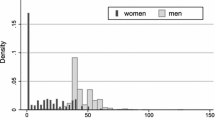Abstract.
We study the Becker and Lewis (1973) quantity-quality model of children adding an explicit child care time constraint for parents. Parents can take care of the children themselves or purchase day care. Our results are: (i) If there only is own care, a quantity-quality trade-off, different from that of Becker and Lewis (1973), arises. The income effect on fertility is positive if child quantity is a closer complement than child quality to the consumption of goods. (ii) If, instead, there is a combination of purchased and own care, the effect of income on fertility is ambiguous, even if quantity of children is a normal good in the standard sense. This is the Becker and Lewis (1973) result extended to a situation with a binding child care time constraint. The conclusion is that the Becker and Lewis (1973) result holds as long as at least some child care is purchased.
Similar content being viewed by others
Author information
Authors and Affiliations
Additional information
Received: 12 November 1999/Accepted: 1 September 2000
Rights and permissions
About this article
Cite this article
Lundholm, M., Ohlsson, H. Who takes care of the children? The quantity-quality model revisited. J Popul Econ 15, 455–461 (2002). https://doi.org/10.1007/s001480100071
Issue Date:
DOI: https://doi.org/10.1007/s001480100071




